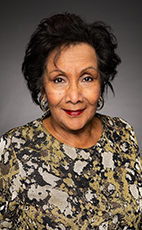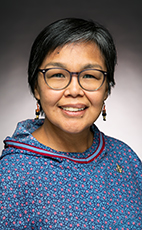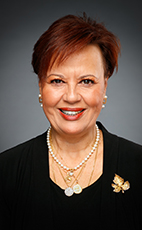44th Parl. 1st Sess.
February 14, 2024
- This bill establishes a new position called the Parliamentary Visual Artist Laureate, whose job is to promote the arts in Canada through Parliament. The Speaker of the Senate and the Speaker of the House of Commons will select the Laureate from a list of three candidates chosen by a committee of art experts. The Laureate will hold office for up to two years and can create art, host events, and give advice on acquiring art for the Library of Parliament. This bill also corrects an error in the reference to the Canada Council for the Arts in the Parliament of Canada Act.
- Yea (215)
- Nay (117)
- add
- star_border
- share
The House will now proceed to the taking of the deferred recorded division on the motion to concur in Bill S-202.
22 words
- Hear!
- Rabble!
- add
- star_border
- share
Pursuant to Standing Order 98, the division stands deferred until Wednesday, January 31, at the expiry of the time provided for Oral Questions.
23 words
- Hear!
- Rabble!
- add
- star_border
- share
moved that the bill, as amended, be concurred in.
9 words
- Hear!
- Rabble!
- add
- star_border
- share
Mr. Speaker, I have the honour to present, in both official languages, the seventh report of the Standing Committee on Canadian Heritage in relation to Bill S-202, an act to amend the Parliament of Canada Act (Parliamentary Visual Artist Laureate).
The committee has studied the bill and has decided to support the bill back to the House, with amendments.
62 words
- Hear!
- Rabble!
- add
- star_border
- share
Pursuant to order made earlier today, the House will now proceed to the taking of the deferred recorded division on the motion at report stage of Bill S‑202, under Private Members' Business.
The question is on the motion.
40 words
- Hear!
- Rabble!
- add
- star_border
- share
Mr. Speaker, there have been discussions among the parties, and if you seek it I believe you will find unanimous consent for the following motion. I move:
That, notwithstanding any standing order, special order or usual practice of the House, the recorded divisions on the motion to concur in the 14th report of the Standing Committee on Health; the second reading of Bill C-284, An Act to establish a national strategy for eye care; the second reading of Bill S-202, An Act to amend the Parliament of Canada Act (Parliamentary Visual Artist Laureate); and the third reading of Bill C-281, An Act to amend the Department of Foreign Affairs, Trade and Development Act, the Justice for Victims of Corrupt Foreign Officials Act (Sergei Magnitsky Law), the Broadcasting Act and the Prohibiting Cluster Munitions Act, be held before the other recorded divisions deferred today.
146 words
All Topics
- Hear!
- Rabble!
- add
- star_border
- share
Madam Speaker, I rise today to close our current debate on the matter of Bill S-202 at second reading, an act to amend the Parliament of Canada Act and to establish a parliamentary visual artist laureate for the parliamentary library.
I would first like to address a couple of comments raised in my colleagues' comments today.
The Conservative member spoke about why this is important when we have issues such as people relying on food banks. I would like to point out, as I did in my first speech in the House, that the arts and artists were very negatively impacted during COVID. As just mentioned, many have not fully recovered yet. It is important to bring attention to the arts and the importance of the arts. They were there for us during COVID, even though their revenues suffered tremendously. That is one of the reasons this position is so important.
We also heard from our NDP colleague about other competing priorities, like pharma care. That is the issue we have with the arts. The arts are often competing against other priorities and they often lose. That is a concern. That is why I think this position, this role, is so important to Canadians and the arts community.
I would like to take a moment to express my gratitude to former senator Patricia Bovey, who has championed this bill every step of the way. Her passion and appreciation for the arts have laid the foundation for our debate, and it is thanks to her that this bill has come to fruition. We owe her our profound appreciation for her invaluable effort and years of service in the Senate.
The bill presented before us today is one that recognizes and embraces the immense value of art in our country. We are surrounded by culture, beauty and a myriad of visual arts. Our art is a reflection of our Canadian identity and the Canadian soul. It unifies us in our endless appreciation and brings us together in admiration of the many artists who have dedicated countless hours to creating captivating works for our eyes.
I would also like to take a moment to thank Senator Wilfred Moore, who first introduced this legislation back in 2016. Although his bill was not able to pass before the dissolution of Parliament, he was the first legislator to introduce the idea of a parliamentary visual artist laureate.
I would like to express my gratitude for the kind words spoken by my colleagues as we have debated this bill. It has been frequently stated that art is universal, transcending barriers of language and ideology. It pleases me to witness the truth of this sentiment and that art has touched all of our lives in some shape or form. It communicates ideas and our experiences from every corner of life.
The Canadian painter Emily Carr once said, “Pictures should be inspired by nature, but made in the soul of the artist; it is the soul of the individual that counts.” It is a profound statement that encapsulates the essence of art and its ability to externalize the depths of an artist's emotions. Through the establishment of this office, we can bring those words to life within the House of Commons. We can give a voice to the soul of our country through its visual creations.
Ms. Carr, like too many other talented artists, was not widely recognized for most of her life. At the time, her artistic approach was neither appreciated nor understood. She suffered the fate of countless individuals who waited years to witness the full recognition of their work, if received at all. It will be the duty of the parliamentary visual artist laureate to seek out that talent, give them a platform and ensure that our artists receive the respect they deserve as soon as possible, not posthumously.
With the passage of this bill and the establishment of this office, we will honour the works, events and exhibitions of Canadian artists everywhere. The creation of a parliamentary visual artist laureate sends a message to the rest of the country and the world: Art is a universal language that knows no boundaries.
Canada respects and celebrates this language, embracing the diverse cultural values within our country. From the Pacific coast to the Québécois to the countless indigenous communities and so many others, we want to dedicate an office that ensures their work does not go unnoticed. We value their immense talent and the contributions they have made to our country. I urge my colleagues to join me in showing our appreciation.
An office such as the one proposed by this bill would serve as an opportunity for many young artists. Its establishment would provide a platform for young up-and-coming artists to gain exposure and support for their craft. It would foster an environment where new talent can proudly showcase their work and achievements to a broader audience. By doing so, we take another step toward fostering a vibrant, thriving artistic community right here at home.
The parliamentary visual artist laureate would serve as a champion of artistic expression and advocate for its recognition within the country. Collaborating alongside the Speaker and members of Parliament, their insight would be an invaluable resource as we consider the profound influences of culture and art on policy.
The passage of Bill S-202 and the establishment of this office symbolize our commitment to celebrating the transformative power of art. By creating this position, we honour our cultural heritage and pave the way for future generations of artists to thrive. I implore all my colleagues to join me in supporting this bill, on division. I look forward to seeing my bill through to its successful conclusion.
965 words
- Hear!
- Rabble!
- add
- star_border
- share
Madam Speaker, I am rising in support of Bill S-202. It is a two-page document. It is very straightforward.
It basically asks the Speaker of the Senate and the Speaker of the House of Commons to select the parliamentary visual artist laureate. It would ensure that the person would hold office for a term not exceeding two years. It would ensure that their mandate would be to promote the arts and culture in Canada, and I will come back to that in a moment, because it is for that reason that I am supportive and the NDP is supportive of this bill.
The visual artist laureate would produce artistic creations, sponsor artistic events, give advice to the parliamentary librarian and perform other related duties. Therefore, the visual artist laureate could play an important role in fostering the arts. This is important; there is no doubt, and I will come back to why this is important in just a moment.
Because it is a brief bill, it is important to comment on what we do in this place. The reality is that private members' legislation can make a huge difference in people's lives. I am going to talk about two bills that have performed that, really responding to the needs of people in a way that is fundamentally important. I am not suggesting the visual arts laureate is not responding to some need. It does help to foster the arts sector, and for that reason we support it.
Last night I was at a vigil on Parliament Hill, just a few steps from this place. Moms Stop the Harm had a vigil for members of their families who had passed away due to the toxic drug supply in this country. It was a profoundly moving event as we listened to each of the families step forward to speak about how toxic drugs had had an impact on their family and about the devastating loss of their loved one. Members will recall that the member for Courtenay—Alberni brought forward Bill C-216, a health-based response to substance use. This bill would have helped those families immeasurably, right across the length and breadth of our country.
This bill on the visual arts laureate will pass easily. I have no doubt that members of all parties will support it, and the visual laureate will be put into place. It is a good thing. I am not suggesting it is a bad thing. It will make a difference in fostering the arts, and, for a number of reasons, that is important.
However, the reality is that Bill C-216, which would have saved people's lives, was defeated in the House, with Conservatives and Liberals voting against it. The Moms Stop the Harm family members who have lost a loved one lament the fact that in this place we are willing to vote for legislation that is sometimes symbolic and sometimes positive symbolism, and that sometimes makes a difference, but we are unwilling to take the courageous step of adopting legislation that would literally save people's lives.
I experienced the same thing in presenting as a private member's bill the Canada pharmacare act. Members will recall that two years ago we had a vote in this place on that. There is no doubt that universal pharmacare saves people's lives. Every single country that has universal health care has universal pharmacare. In Canada, the Canadian Nurses Association tells us that hundreds of Canadians die every year because they do not have the financial resources to pay for the medication that will keep them in life. There is no doubt that a private member's bill putting the foundation in place for universal pharmacare would have made an enormous difference in people's lives, yet, again, Conservatives and Liberals in this place voted that down.
We have a symbolic piece of legislation, a private member's bill that we do not oppose, to establish a visual artist laureate. It will be adopted by all members of Parliament voting together. We will vote unanimously, perhaps, to put in place a visual artist laureate, but what about universal pharmacare? What about putting in place health care measures that would actually save people's lives and provide support to those who have addictions and are struggling with substance use?
This is what I find difficult: It is that while we can reach unanimity around things that do not necessarily make a difference in people's lives, time and time again, as a House, as members of Parliament, a majority of us vote against the essential measures that would actually make a difference.
With that caveat, I would like to return to Bill S-202 and what I hope will come out of this.
The reality is that the arts sector in Canada has been a major motor of the economy. I would particularly like to shout out, as the member of Parliament for New Westminster—Burnaby, to the Arts Council of New Westminster and the Burnaby Arts Council for the work they do each and every day to foster the arts and to foster community togetherness in our communities.
The two communities I represent have very strong artistic sectors, and it is the volunteer work that folks have been doing over years that has led to that. We have been very fortunate in the communities I represent.
However, with COVID we have seen how the arts sector has been hard hit, right across the country, with a 25% decrease in employment levels in arts, entertainment and recreation. In many cases, we are seeing a one-third loss or a 50% loss of gate receipts for festivals and for performing arts, so there is no doubt that the arts sector particularly suffered through COVID and has not been fully revived.
For that reason, it makes sense to ensure that a parliamentary visual artist laureate position is put in place and that the laureate immediately starts to work to help publicize the arts sector, to help make a difference in the arts sector, and in a sense to help to revive the arts sector.
I believe fundamentally that we need to contribute to the arts sector and make that difference right across the country, and the member for Nunavut just agreed with me. The member for Nunavut is a huge supporter of the arts. As we know, Nunavut is a major engine of the arts but is not receiving the support from the federal government that I think other parts of the country should be receiving.
The federal government needs to step up far beyond the issue of putting in place the parliamentary visual artist laureate. There is also the restoration of funding that needs to take place right across the country, I would suggest in New Westminster—Burnaby, Nunavut, North Island—Powell River, Nanaimo—Ladysmith and South Okanagan—West Kootenay, as well as right across the country. I have colleagues who represent very vibrant arts sectors in those communities. In fact, I have been to every one of them. It is amazing what the arts sector does in every one of those communities—shepherded and supported by strong members of Parliament, I would add.
The reality is that the federal government has not been there since COVID. There was support that the NDP forced through during COVID to ensure that much of the arts sector that was hard hit by COVID made it through, but now the federal government is stepping back and saying that they are on their own.
There is the exception, in that we will have a parliamentary visual artist laureate, but that is only a small step in what is actually needed to provide supports to the performing arts and the festivals of arts and culture right across this country.
This is fundamentally important. It goes far beyond the private member's bill. We are sometimes called upon to speak to private member's bills that are symbolic; in some cases they are symbolic, but they have added elements. In this case, there is a symbolism that does provide for other elements, the promotion of the arts on Parliament Hill. Hopefully it will make a difference in the federal government's response to the artistic sector, because ultimately, the federal government needs to step up and go beyond this private member's bill.
1411 words
- Hear!
- Rabble!
- add
- star_border
- share
Madam Speaker, it is indeed an honour and a privilege to rise today to speak to Bill S-202. I want to begin by acknowledging the importance of the arts and culture in Canadian life. While the motivation for this bill may be admirable, I do question, at a time when one in five Canadians is skipping meals, when we see record-high food bank usage, when we see Canadians struggling to make their rent and mortgage payments, why the government would use a Senate public bill to advance such a matter.
That said, I am pleased to rise and speak to various issues related to Bill S-202, an act to amend the Parliament of Canada Act regarding a parliamentary visual artist laureate. I must admit that I personally am not much of an artist. I am not an expert on the art world. I am one of those people who know when art looks good or what I think looks good, although many people will not agree with my perspective. Certainly, I do not have many original artworks hanging in my home. Those I do have that are originals were created by some of the cutest constituents in my riding, aged seven, nine and five.
However, I do appreciate the art that our world creates and, certainly, in my riding, as in so many ridings across the country, there are many opportunities to see those great works of art at the local level, in places like Minto or Stratford, whether it is the Gallery Stratford or the weekly Art in the Park enterprises in Stratford.
Bill S-202 proposes to create the position of a parliamentary visual artist laureate, who, according to the bill, will be “an officer of the Library of Parliament.” This bill follows a similar formula that was used over 20 years ago to create the parliamentary poet laureate.
It is important to recognize that here on Parliament Hill, we do indeed have an impressive collection of visual art. Many of us who were privileged enough to be able to sit in the original Centre Block, and certainly some of us miss that historic building, will know some of the work that was included in that building. After it was rebuilt, on February 3, 1916, many visual artworks were included in it. It had many great paintings and sculptures, many of which were carved in the interior Centre Block stone itself.
What many might not know is that much of the stone in Centre Block was deliberately left unmarked upon construction so that future art could be carved into the building over the decades. The art on Parliament Hill was sculpted as our country was sculpted.
What is more, outside this very chamber are the portraits of many former Speakers of the House of Commons and the portraits of 21 of the 22 former prime ministers. I am personally quite fond of the painting of Canada's ninth prime minister, Blanshard Township-born Arthur Meighen, the right hon. member who was perhaps the greatest orator that this House has ever seen.
It was, in fact, Canadian historian Arthur Milnes, when he was doing work on a project on Arthur Meighen, who discovered a serious blunder related to that portrait. While the portrait had been displayed on Parliament Hill since it was painted by Ernest Fosbery in 1948, it had never been officially unveiled or dedicated. Fortunately, that oversight was corrected when then prime minister Stephen Harper, then Speaker Peter Milliken, former prime minister Joe Clark and then senator Michael Meighen rectified the situation and held an official portrait unveiling in February 2011.
As a side note, I would note that this past Tuesday evening, I had the great privilege of speaking with our former Senate colleague, Michael Meighen, at the opening night of the Stratford Festival's 2023 season. It gives me the opportunity to highlight former senator Meighen and the Meighen family for their strong support of the Stratford Festival and, in particular, the Meighen Forum, which makes such contributions to thoughtful reflection on the arts and culture in Canada.
Back to the Meighen portrait, it was displayed in Centre Block with the other prime ministerial portraits until they were moved here in 2018. While it is unfortunate that the formal portrait unveiling did not occur while Arthur Meighen was still alive, perhaps having a parliamentary visual artist at the time may have rectified that situation.
I did mention that the portraits of 21 of our 22 former prime ministers are hung on these walls. The one that is missing is our former prime minister Stephen Harper, who is yet to have his own portrait unveiled. I know all members are looking forward to the day when we unveil his portrait as one of Canada's great leaders of this century.
Another great work of art that hangs within the parliamentary precinct is entitled The Ghosts of Vimy Ridge. It was painted in 1928 by William Longstaff. This magnificent work shows a dark sky over the Vimy Ridge memorial in France. The description of the painting from the House of Commons says:
On Easter Sunday, 1917, Canadian soldiers launched a bloody, victorious attack on the German-held Vimy Ridge. This battle is considered a defining moment for Canada coming into its own as a young country.
In William Longstaff’s oil painting, The Ghosts of Vimy Ridge, the spectres of almost 3,600 fallen Canadian soldiers trod back to camp, through shell-pocked ground and darkness, guided by light from below that illuminates Walter Allward’s massive Canadian monument.
Longstaff, an Australian, sold the painting to Captain John Arthur Dewer, of the Dewer distillery family, who presented it to Canadian Prime Minister R.B. Bennett in 1931.
This painting used to hang in the railway committee room of Centre Block, where the opposition parties held their caucus meetings. However, since the closure of that building, it has been moved to the main floor of the Wellington Building, a building in which I am pleased to have an office. I am able to pass by that painting each day on my way to work. It reminds us of the bravery and sacrifice of so many Canadian soldiers who helped make this country what it is today.
Recognizing that the bill is likely to pass, I would encourage the first holder of this position to prioritize the creation of more paintings and artworks to honour the Canadian soldiers who gave their lives in other battles, including at Normandy, in the Korean War, in more recent peacekeeping missions and, certainly, in the war in Afghanistan. I would note that, about two months ago, I learned of a great painting in Cambridge, Ontario, that honours the lives of the 159 Canadians who died in Afghanistan. This painting needs a new home, and I think it would be appropriate that such a painting be displayed here on Parliament Hill.
Before I wrap up, I want to highlight one visual artist from my riding, Horatio Walker. Born in Listowel in 1858, Horatio Walker was primarily a self-taught artist, and he soon became known for his beautiful paintings depicting rural life in Canada. He was elected to the Royal Academy of Canada in 1918, and he became its president in 1925. However, his works have never been displayed here on Parliament Hill, nor have I found a record of any of his paintings displayed within the precinct.
Part of the mandate for the parliamentary visual artist laureate, as provided in Bill S-202, is to “give advice to the Parliamentary Librarian regarding the collection of the Library and acquisitions to enrich the Library’s cultural holdings”. If this position is created, I hope that the first parliamentary visual artist laureate will take the initiative and ensure that at least one of Horatio Walker's great paintings, which depict the spirit and beauty of life in rural Canada, will be displayed here on Parliament Hill for all Canadians who come here to view and reflect upon. I know for a fact that just a kilometre from here, a few of his paintings are sitting in storage at the National Gallery, where they are not being viewed by anyone. It would be wonderful if just one of them came to Parliament Hill, so that they could be seen by so many.
As well, indigenous art has often been undervalued and unseen in Canada's history. I am hopeful that, if this bill were to pass before this Parliament dissolves, a future visual artist laureate would make a concerted effort to ensure the work of indigenous artists are made well represented within this place. Certainly, as shadow minister for Canadian heritage, my office was in contact with a gentleman in New Brunswick who is looking for a home for several pieces of indigenous art from the great Christian Morrisseau. Thus far, he has found little receptiveness to placing them here. I would hope that the new parliamentary visual artist laureate would find a way to make that happen.
To conclude, Canada is home to so much great art, as well as so much great culture, that we ought to celebrate it and share it with all Canadians.
1551 words
- Hear!
- Rabble!
- add
- star_border
- share
Madam Speaker, before I begin my speech, I want to assure the member for Joliette that we are not planning to call an election this year.
I am rising today to express my support for Bill S‑202, an act to amend the Parliament of Canada Act with regard to a parliamentary visual artist laureate. This bill recognizes that we do our best work as legislators when we are informed by many types of knowledge and that visual arts are included in the essential foundation of thinking and understanding that the Library of Parliament represents.
As the official representative of the Library of Parliament, the visual artist laureate would create works of art, organize events and enrich the Library of Parliament's holdings in order to promote the arts in Canada. Like our poet laureate, who condenses big revelations into small constellations of carefully chosen words, a visual artist laureate would, through their creations, not only give us something new to see but also give us new ways of seeing things. We could certainly use that right now.
I have had the privilege of serving Canadians in Parliament over the course of the COVID-19 pandemic, and the experience has allowed me to confirm, on a large scale, many of the ideas I have long held about the people living across this country: their resilience, their stamina, their care for one another and their incredible hard work. I have also seen some breathtaking reminders of Canadians' imagination and creativity, extraordinary artwork that has revitalized our hopes, enlivened our thinking and allowed us to remain connected to our common humanity despite the distance between us.
While it is definitely not my goal to minimize the painful feelings of separation and isolation that so many Canadians experienced during the early days of the pandemic, I have had the pleasure of meeting many people who are making deep connections with each other that are not solely based on being in the same place at the same time.
We bear witness to one other when we communicate what we really care about, and today we have many ways to convey those thoughts and feelings. Some choose new technologies, which have reached heights we never thought possible before the pandemic, but many people choose to do things differently. For example, the information communicated through a letter is very different from a live dialogue between two people.
Similarly, the arts represent a beautiful language for expressing ourselves and showing others what gives meaning to our lives. Art is also a powerful means of expressing the important issues that are at the heart of our experiences. It is an extremely effective tool for understanding and resisting the tumultuous times we are living in and for imagining a better world.
These new visions that Canadian artists could offer are not bound by the constraints of literal eyesight. Take Bruce Horak, for example, a Calgary-born visual and performing artist. He had a cancer in childhood that took most of his eyesight. Since then, he has been legally blind.
Speaking of his journey to painting in one of a series of interviews with artists from the Disability Arts Movement, presented by Tangled Art + Disability and the Art Gallery of Ontario, Mr. Horak said, “People would ask me how I see, how I am able to do what I do with 9% vision, so I started painting portraits to try to capture the way I see the world. That includes auras and halos and floaters and a lot of distortions...I painted a portrait a day for a full year and really enjoyed the connection that happened between myself and my subject.”
Since beginning this project in 2011, he has painted over 600 individual portraits from live and virtual sessions, giving his subjects the opportunity to see themselves in a new way. Similarly, the visual artist laureate could facilitate more of these perceptual transformations, changing how Canadians see themselves and demonstrating the inherent richness that every different way of seeing brings to our collective.
That richness has so often been squandered, whenever different ways of seeing have been shut out, cut down or marginalized. We lawmakers must take action to see our country's problems from other perspectives. Our vision captures only a pinhole of the bigger picture. For us to make just laws, we must work harder at seeing everyone and everything as they truly are.
In an inspiring artwork from 2019, Montreal artist Michaëlle Sergile used Maya Angelou's voice reciting The Mask, which is a mash-up of We Wear the Mask by Paul Laurence Dunbar, a 19th century Black poet, and Angelou's own poem For Old Black Men, to translate sound into something visible, tactile and entirely new.
The sound waves of Angelou's masterful and devastating performance of this piece, which speaks to the pain and injustice Black people have had to mask with laughter, is mapped with a spectrograph into a visual pattern. It is then transformed again into something new and richly layered by weaving that pattern into a black and white mix of cotton, alpaca and acrylic, with these broad, shawl-like ribbons of Maya Angelou's voice in fabric, cascading down the gallery wall. How would it change us if we could literally wrap the sound of those words around our shoulders?
A visual artist laureate could open up a gateway to transformative experiences such as these, not just for legislators, but for all Canadians.
When Gabrielle Roy, one of the most celebrated authors of 20th century French-Canadian literature, asks, “Could we ever know each other in the slightest without the arts?”, she reminds us that certain parts of ourselves can only be reached by taking detours, through metaphors and representations, through poetry and art.
No matter how many people we share our time and space with, we live most of our lives inside our own heads. I would never call this a small space, though. Our inner world is like an ocean, full of mysterious, undiscovered spaces.
Even though most of us know the path that runs along the shore, we are not comfortable spending time on the other side of the sandbar, beyond where our feet can touch the bottom, all alone, deep underwater, under pressure, in the unfathomable valleys of our being.
Still, it is in these strange and isolated places that artists create most of their work. Their creations allow us to escape the confines of our consciousness, if only for a brief moment, and see life through the eyes of another person, in order to connect the submerged continents that separate our many ways of being.
We must take every opportunity to enjoy the discoveries we make on these introspective journeys and recognize the courage of artists who resist the pressure to explore the deepest parts of their souls. We must examine, with courage and curiosity, both the treasures and the ruins they bring to the surface, in order to better understand who we are and where we come from. We need to pass Bill S-202 and create the position of parliamentary visual artist laureate.
1199 words
- Hear!
- Rabble!
- add
- star_border
- share
Uqaqtittiji, I am happy to rise today representing Nunavummiut on the importance of Bill S-202, an act to amend the Parliament of Canada Act, sponsored by the member of Parliament for Bow River in Alberta. The bill proposes to create a position called the parliamentary visual artist laureate. The person holding this position would then be an officer of the Library of Parliament, promoting the arts in Canada.
Before I begin, I would like to acknowledge that today is National Indigenous Languages Day. I thank Her Excellency the Governor General for raising awareness on this day. Today on her website, she educated us about the word “ajuinnata”. Translated into English from her Nunavik dialect, ajuinnata “means to never give up, no matter how difficult the task ahead might be.”
One word I will remind the House of is the word I start with every day in my speeches in the chambers. I say “Uqaqtittiji” all the time, and people still ask me what that means. Uqaqtittiji means the one who gives space to speak. The term has no gender attached to it, so when I say it, I do not need to worry if it is the member for Algoma—Manitoulin—Kapuskasing, the member for West Nova or the member for Brossard—Saint-Lambert sitting in the chair.
To get back to Bill S-202, visual arts are an important expression of identity, both individually and collectively. Individual artists are lucky enough to have the talent and skills to express any and all of the emotions those of us who are less talented wish we could express. Indeed, I share gratitude for their talents.
The collective identity comes from different backgrounds. Predictably, I will speak to the Inuit and indigenous contributions to Canada’s national identity. The contributions by Inuit and indigenous visual artists to Canada’s collective identity are vast and expansive. I have only to mention Qinnuajuaq, or as non-Inuit say her name, Kenojuak Ashevak, for members to imagine her beautiful owl prints, which are so commonly sold in museums today. Qinnuajuaq was said to have been born on October 3, 1927. She died on January 8, 2013.
Qinnuajuaq was born in an igloo at a camp called Ikirasaq at the southern coast of Baffin Island. In the 1950s, Qinnuajuaq was sent to a hospital in Quebec City against her will after having tested positive for tuberculosis. Because of the adversity and strength she had, Qinnuajuaq became an icon for sharing her talents.
When I mention Germaine Arnaktauyok, members can imagine the design on the iconic two-dollar coin that was issued by the Royal Canadian Mint in 1999. Germaine showcases the beauty of Inuit in her artwork. Germaine is an Inuk, and she has illustrated several books. I am inspired by her, as she always expresses the strength of Inuit in her works.
I love the artwork of Tanya Tagaq. She is more well known for her modern throat singing, which is just as powerful as her visual art. The last time I watched Tanya perform, I had goosebumps. When I read her book, Split Tooth, I felt surrounded by her enthralling expressions. I look up to her for her courage and for being an Inuk warrior.
Blake Angeconeb is a talented Anishnaabe artist who was commissioned by Google, and worked with Danielle Morrison, to commemorate the great works of Norval Morrisseau. Thinking of Norval always reminds me of discovering the use of his works in the iconic movie The Shining.
Blake, by the way, has a great collection of works available on his website, including a description of Moving Forward, Together, which was commissioned by Bimbo Canada as part of a five-year commitment with the Gord Downie and Chanie Wenjack Fund. It is within “a Legacy Space to build cultural understanding, connections and a path to reconciliation between Indigenous and non-Indigenous peoples.”
Another great visual artist is Christi Belcourt, a Métis visual artist who is best known for her acrylic paintings. Christi is an amazing activist. Through her works, she leads us to do better for our environment. I love particularly that she worked in solidarity with Inuit hunters from Pond Inlet and Arctic Bay and created “Respect Inuit or Leave”. This work was particularly important as it helped contribute to the protection of Inuit rights and values to protect the environment and wildlife surrounding Baffinland Iron Mines' proposal to expand its Mary River iron ore project, which is having a targeted impact on five communities in the Qikiqtani region.
COVID-19 left such a huge impact on Canada and the world. Many artists were particularly impacted. According to research from Hill Strategies Research in October 2021, there was a 25% decrease in employment levels, including self-employment, in the arts, entertainment and recreation, higher than any other industry in 2020. Yet COVID-19 showed us just how important visual art is. As we all turned to Zoom, Teams and other software to join in meetings, we all became purposive in what we would show as our background. At one point, I remember specifically wanting to showcase the beautiful artwork of Madeleine Qumuatuq as she uses her surroundings to express her works, including the beautiful tundra she is surrounded by in Pangnirtung.
If Bill S-202 passes, we must ensure that when the House of Commons Speaker and the Speaker of the Senate, acting together, select Parliamentary visual artist laureates, they are indigenous. Canada enjoys its diversity because of indigenous peoples. Canada enjoys its diversity on indigenous people's lands. Canada must express its commitment to ongoing reconciliation by ensuring that among its first Parliamentary visual artist laureates will be Inuit, Métis and first nations.
972 words
- Hear!
- Rabble!
- add
- star_border
- share
Madam Speaker, I am pleased to rise this last Friday before the break to speak to Bill S‑202, which would create the position of visual artist laureate for the House. I want to draw some parallels to something similar that we are already familiar with and that my colleagues mentioned, the position of poet laureate. I will even refer to some speeches that were made at the time. We will go back to 2001 when that position was created, and I will speak about certain differences and also certain similarities between the two positions.
When the position of poet laureate was first created, the Bloc Québécois was concerned about the language issue. Indeed, a poem in its original language is never the same as its translation. We used to joke that in this chamber there are always two official languages, English and simultaneous translation.
Other than the fact that we do not anticipate any linguistic issues with the visual arts, one of those differences is that the role being created does not have the same scope. Back when there was a poet, that person was asked to try to poetically express the rhythm of Parliament, which is in itself an enormous task, consisting of bringing our work to life artistically. However, the poet also faced a challenge to create works destined to be read in the House or during official events.
In this case, the artist will have a somewhat different role. The artist will be able to produce works themselves, but they will also be able to cause work to be produced, sponsor artistic events, give advice to the Parliamentary Librarian, in particular, regarding acquisitions. They will also be able to perform such other related duties as are requested by the Senate or the House of Commons. The role of the future visual artist is, then, slightly different from that of the poet.
The nature of the art will also be different. Poetry is a bit more limited in terms of scope, whereas, here, the visual arts can include drawing, painting, sculpture, printmaking, design, crafts, photography, videography and filmmaking. The choice of medium that the artist can use is much broader than words, which is what the parliamentary poet laureate uses.
Our Conservative colleague mentioned the matter of cost. We are not really bothered by that because, for $100,000 a year, we expect the parliamentary visual artist to be much more cost-effective in terms of productivity than the Governor General, for example. The Bloc Québécois therefore does not feel the cost to taxpayers is an issue here, and we are hoping that the works that are produced will be a great source of inspiration for everyone.
There are perhaps some things, however, that might bother me about the position. Art can be an extremely effective political weapon, so I hope that the position of visual artist will not be politicized. We do not want there to be a mandate to politicize the art, and we hope that the artist will have as much freedom as possible in their work.
I am indulging in some wishful thinking about the artist's work. If their art is meant to reflect the diversity of Canada, I would hope that the diversity will include the fact that there is a francophone minority outside of Quebec and that Quebec itself is a francophone minority within Canada. That should not be forgotten; it is part of Canadian diversity. We dare to hope that this will be reflected in the artist's work.
I was talking about politicizing art and here is an example. As recently as last December, we were in the midst of a pre-holiday discussion, if not storm, in the House about the role that the National Gallery had taken on in decolonizing art. There, in the middle of Riopelle's centennial year, members ruled out the idea of having an exhibition dedicated to this artist. When I talk about politicizing art, that is exactly what I am hoping will not happen with the role of the visual artist.
I was also talking about the freedom that an artist has if we avoid giving mandates. I will take the liberty of quoting from a speech by Madeleine d'Alfond-Guiral, who spoke about creating the position of poet at the time. I understand that this speech earned her the biggest laugh from the current member for Montarville in the House. I have promised myself that I will look up the video excerpt of that speech someday. I would like to read a more serious portion of it.
The second question concerns me most. Is freedom the poet's most precious asset?
I know that it is for me, and there is no end to the number of people who have chosen to die for freedom.
What about poets? Some of the greatest have mouldered in prison in the defence of freedom. As prisoners, they were no less free. Who can name a single poet who agreed to trade freedom for money or power? Honestly, I cannot think of one.
It is true that Bill S-10 would give the poet laureate the great responsibility of writing poems to be read in parliament at official ceremonies.
Could we conclude that the poet laureate is non partisan? Probably. And yet, it is hard not to imagine that finding oneself promoted to the position of poet laureate of parliament for two years would not of necessity create obstacles that, insidiously, would limit later speech and give it serious bias.
How to be free when the choice of poet laureate would be made by a few persons, some of whom had received political appointments? As the saying goes, “Don't bite the hand that feeds you”. “Elementary, my dear Watson”.
I hope that a mandate that would undermine their freedom would not explicitly or implicitly be imposed on the artist.
Still, good things will result from creating this position. In the context of a pandemic that made life difficult for artists, it is a good thing to promote the work of artists. I will give a few examples. We know that, during the pandemic, many cultural events were cancelled and exhibit spaces were limited or even closed to the public. There were problems with funding for artists. Even artists experienced psychological distress because they were unable to work and earn a living with dignity.
We know that the income of artists is often much lower than that of the rest of the population. Many live below the poverty line. There is still a power imbalance between broadcasters and artists. Their precarious financial situation worsened even before the pandemic. We may have lost our sense of philanthropy and desire to fund the arts.
As to the precarious situation of artists, I think the beauty of the bill is that it sends a message to artists. I only hope that it will not be the only one and that arts funding will never be a partisan issue in the House, although that might just be wishful thinking. In this context, creating this position is a beautiful thing. I wonder what impact creating this position will have on the House of Commons.
I want to quote two people who lived in very different eras. The first, Hippocrates, said, “Life is short, and art is long”. A more contemporary take on this comes from Bob Dylan, who said, “The purpose of art is to stop time”.
We have an incredible ability in the House to play with time. We could say right now that it is June 23 at 2:00 p.m. and that we are all going home to celebrate our national holiday. We have a lot of latitude in the House when it comes to time, but we do not have the power to stop it entirely. Who knows, perhaps, with the arrival of the new visual artist in the House, we will have given ourselves one more way to play with time.
1358 words
- Hear!
- Rabble!
- add
- star_border
- share
Madam Speaker, I say good day to everyone. It is a pleasure to rise in the House this afternoon to talk about Bill S-202, an act that would amend the Parliament of Canada Act and that is better known as the parliamentary visual artist laureate.
This Senate bill proposes to establish a new officer of the Library of Parliament called the parliamentary visual artist laureate and to give that position a term of up to two years. This new officer would be tasked with creating works of art for Parliament and engaging with visual arts communities from coast to coast.
The Parliamentary Budget Officer assumes that the overall cost of a visual artist laureate would be in the neighbourhood of $100,000. This is based on the cost of the established parliamentary poet laureate position we already have.
My Conservative colleagues and I support the arts in this country, as well as the culture and diverse heritage of Canada. Through my work over the past eight years on the Standing Committee on Canadian Heritage, I have had many opportunities to learn from Canadians and demonstrate that support. My colleagues on this side of the House and I, on the heritage committee, have heard many witnesses testify from the arts community who are struggling financially. We have made common sense suggestions to the government for legislation to support these artists in our country.
Unfortunately, I have been disappointed by the lack of support by the Liberal government for online content creators; let us make no mistake, they are really artists themselves. Bill C-11 threatens some of these artists, and no amount of testimony or discussion has caused the government to even give this issue a second look. This is an avoidable mistake.
Many artists came to committee to talk about the online streaming bill that gave them the opportunity to connect not only in their community and this country of Canada but worldwide. These are the same artists and creators who have made a name for themselves but are now being censored, and last night, the government moved closure on Bill C-11.
The Senate looked over Bill C-11 for months and recommended 26 amendments. Even the Senate agreed that this was a huge issue in the red chamber. However, the government refused eight amendments that dealt with censorship. These are artists who may never have a chance to make $100,000 a year, but like this Senate bill, it is all about freedom of expression.
It is interesting that Bill S-202 does not refer to it, because when another creative bill was being studied, it was all about limiting the freedom of expression. With regard to this legislation, Bill S-202, I will remain optimistic and open-minded. I will listen to members, who will no doubt deliver thoughtful remarks, and I will listen to all Canadians. However, I will remind everyone that it is Canadians who will bear the brunt of the cost of this bill, and I will listen closely to hear their thoughtful views.
I regularly send information into my riding requesting feedback. I am never disappointed by the range of opinions and carefully considered comments we get back. I learn something every time we send out a mailer and interact with constituents. Canadians, as we all know, are very smart, and I trust them to make good decisions about how we spend their money here in Parliament.
We will get the opportunity to hear from Canadians when this bill goes to committee. We will hear from witnesses and gather more information. For example, was there a demand for the creation of this position in the first place? What work is expected to be produced by the individual in this position? How would this individual be selected? Would the work produced reflect Canadian values we can be proud of? Are there any limitations on their work?
Some of the questions we are talking about here today are about what we need to find out in committee. These are just a few important considerations. As we all know, Canada is rich in talent in every artistic field.
I have been privileged to travel to every coast of this country, and I can say that Canadians are creating art every day in every way across this great country. My office in Saskatoon, in fact, is decorated with meaningful art pieces by talented Canadians, including my own wife, Ann.
The late Bob Pitzel from Humboldt made a number of paintings that I have in Saskatoon and here in my Ottawa office, and I cherish them. Ann and I have supported artists for years by buying their treasures and helping non-profit organizations like Artists Against Hunger, which raises money for local charities in our city of Saskatoon.
There is no shortage of creativity and talent in Canada. In fact, I had an opportunity to visit Stornoway just before Christmas. That is the residence of the Leader of the Opposition. On the wall, I was pleased to see a painting by the late Allen Sapp, an artist from Saskatchewan. It was a painting from his catalogue that I had tried to purchase for myself, but it was not available; then I saw it on the wall at Stornoway. I guess I cannot take that picture back home with me.
Allen Sapp, who unfortunately passed away in 2015, was an indigenous artist; he really set the table in our province for art. In fact, in the city of North Battleford, there is a museum that all Canadians should go to. Allen Sapp was one of the finest painters that this country has ever seen.
Could a collection of artists who are already creating art contribute their work in order to fulfill the goal of Bill S-202? I just throw that question out there. These are options that we might consider before creating a new exclusive post.
This bill proposes mandating a visual artist laureate to promote arts here in Canada. Canadians have been doing this since the birth of this nation, some 150-plus years, without a mandate. Art is an amazing thing. Creativity does not need to be mandated.
COVID was particularly difficult for artists in this country. It was difficult for everyone, but certainly in the area of the arts. Artists could not show their work, and it was very tough on them. We heard from them at heritage committee. This is a sector that I would like to hear from on the idea of a visual arts laureate. They would provide a level of understanding that should be heard.
With the reckless spending and the runaway debt under the current government, it makes sense to hear from Canadians what they want. Do they feel this is value for money, or do they have other priorities for arts funding in this country? Is this the best way to support artists in Canada, and is it the best time to create new expenses?
I would like to thank my hon. colleague from the other place, the senator from Manitoba, for this bill. I think we can all agree that members in the House support the arts, culture and diversity. There are many ways to support that priority in Canada.
I would like to thank some of the artists from my city. There is the late Hugo Alvarado. Cam Forrester has a group in our city called Men Who Paint. It has several exhibitions. It is a fabulous group of artists in Saskatoon. It does tremendous work, and its members volunteer their time for workshops, which helps younger artists get involved.
We have Cheryl Tuck Tallon. Ernie Scoles is indigenous, and he does so much in our city, like volunteering items for promotion at fundraising events. We also have Lorna Lamothe, Laurel Schenstead-Smith, Marian Phaneuf and I could go on.
I thank members for their time on Bill S-202.
1324 words
- Hear!
- Rabble!
- add
- star_border
- share
Madam Speaker, the parliamentary artist laureate would complement these commitments by creating an opportunity to celebrate Canadian visual arts and artists, and by projecting a global image of open-mindedness, creativity and innovation.
Canadian artists from across the country, whether they be lifelong Canadians, immigrants or indigenous peoples, would benefit from having a parliamentary artist laureate here in Ottawa. The appreciation of the arts unites us, and in a multicultural country such as Canada, we should be promoting our many different forms of art at every given opportunity.
In summary, supporting Bill S-202 recognizes the importance of visual arts to the Canadian creative economy, supports diverse artistic expression by Canadian artists, raises the profile of Canadian visual arts in Canada and abroad, and demonstrates that the government values the contributions made by contemporary Canadian visual artists.
I look forward to the discussion we will have here today, and I am hopeful Bill S-202 will receive support from all the parties represented here in the House of Commons. I hope all members will join me in celebrating the arts in our country.
183 words
- Hear!
- Rabble!
- add
- star_border
- share
moved that Bill S-202, An Act to amend the Parliament of Canada Act (Parliamentary Visual Artist Laureate), be read the second time and referred to a committee.
He said: Mr. Speaker, it is a great honour to rise today in the House to speak to Bill S-202, an act to amend the Parliament of Canada Act to create a parliamentary visual artist laureate. This bill was first introduced and passed through the Senate by my good friend Senator Patricia Bovey. I would like to thank my friend and colleague, the MP for Bow River, for allowing me to take the lead at second reading of this bill.
To provide some historical context, Bill S-202 was first introduced during the 42nd Parliament as Bill S-234 by Senator Wilfred Moore in 2016. It was adopted at all stages in the Senate before dying on the House of Commons Order Paper. It was subsequently reintroduced by Senator Bovey in the 43rd Parliament as Bill S-210 and then again after prorogation as Bill S-205.
When this previous rendition was introduced, former MP Lenore Zann acknowledged artist Peter Gough of Nova Scotia, who was the originator of this wonderful idea. Sadly, Peter passed away before he could see his idea become reality. I should mention that the House heard several wonderful speeches here when MPs debated Bill S-205. It was clear that the House supported the bill, and it was very interesting to hear the importance of the arts from MPs of different parties.
This bill has reached the House of Commons three times previously and at various points has received unanimous support. The most recent time this bill was before the House was in the 43rd Parliament. On the day this bill was to be voted on for the third time, Parliament was dissolved, and now I am able to bring this bill back again, hopefully for its final time, to see it through to its successful conclusion.
Bill S-202 seeks to create the position of a parliamentary visual artist laureate. The artist laureate would be an officer of the Library of Parliament, similar to that of the parliamentary poet laureate position. The position of parliamentary poet laureate was created in 2001 through Bill S-10, which included similar amendments to the Parliament of Canada Act. Bill S-10 gathered broad support from senators, and in the House of Commons, Bill S-10 was supported by a majority of MPs.
The selection process would consist of the Speaker of the Senate and the Speaker of the House of Commons acting together to select a parliamentary visual artist laureate from a list of three names reflective of Canada's diversity, including indigenous representation. These names would then be submitted by a committee chaired by the Parliamentary Librarian and composed of the director of the National Gallery of Canada, the Commissioner of Official Languages of Canada, the chairperson of the Canada Council for the Arts and the president of the Royal Canadian Academy of Arts, or their designates. As for the tenure of office, the parliamentary visual artist laureate would hold office “for a term not exceeding two years, at the pleasure of the Speaker of the Senate and the Speaker of the House of Commons acting together.”
The mandate for this laureate position is to “promote the arts in Canada, through Parliament, including by fostering knowledge, enjoyment, awareness and development of the arts.” In carrying out their mandate, the laureate may “produce or cause to be produced artistic creations, at the request of either Speaker, especially for use in Parliament on occasions of state.” They may also sponsor artistic events such as art competitions or exhibitions. The laureate could also “give advice to the Parliamentary Librarian regarding the collection of the Library and acquisitions to enrich the Library’s cultural holdings”.
In this bill, arts are defined as “drawing, painting, sculpture, printmaking, design, crafts, photography, videography and filmmaking.”
672 words
- Hear!
- Rabble!
- add
- star_border
- share
All those opposed to the hon. member moving the motion will please say nay.
It is agreed.
The House has heard the terms of the motion. All those opposed to the motion will please say nay.
36 words
All Topics
- Hear!
- Rabble!
- add
- star_border
- share
Madam Speaker, there have been discussions among the parties, and if you seek it, I believe you will find unanimous consent to adopt the following motion.
I move:
That, notwithstanding any standing order, special order or usual practices of the House:
(a) Bill C-278, An Act to prevent the imposition by the federal government of vaccination mandates for employment and travel, standing on the Order Paper in the name of the member for Carleton, shall now stand in the name of the member for Niagara West and be placed in the order of precedence at the same place and stage as Bill C-285, An Act to amend the Canadian Human Rights Act, the Canada Labour Code and the Employment Insurance Act, and be deemed to have been reported to the house pursuant to Standing Order 91.1 recommending it not be designated non-votable, and the order for the second reading of Bill C-285 shall be discharged and the bill withdrawn;
(b) Bill S-202, An Act to amend the Parliament of Canada Act (Parliamentary Visual Artist Laureate), standing in the name of the member for Bow River, shall now stand in the name of the member for Cloverdale—Langley City; and
(c) Bill S-4, An Act to amend the Criminal Code and the Identification of Criminals Act and to make related amendments to other Acts (COVID-19 response and other measures), be deemed adopted at report stage on division and be deemed adopted at the third reading stage on division.
256 words
All Topics
- Hear!
- Rabble!
- add
- star_border
- share
moved that Bill S-202, An Act to amend the Parliament of Canada Act (Parliamentary Visual Artist Laureate), be read the first time.
He said: Mr. Speaker, I rise today to present Bill S-202, an act to amend the Parliament of Canada Act (Parliamentary Visual Artist Laureate). It is seconded by the hon. member for Saskatoon—Grasswood, a long-time promoter of heritage in this country, especially if it involves sports, and a great member of the heritage committee. This bill intends to create the position of parliamentary visual artist laureate and corrects a reference to the Canada Council for the Arts in the English version of the Parliament of Canada Act.
The mandate of the parliamentary visual artist laureate would be to promote the arts in Canada through Parliament, including by fostering knowledge, enjoyment, awareness and the development of arts. This position would highlight the importance of art in our culture and in our communities. It would serve as a method for historical preservation of Canadian arts. It will hopefully be studied soon by the heritage committee.
180 words
- Hear!
- Rabble!
- add
- star_border
- share
I have the honour to inform the House that messages have been received from the Senate informing this House that the Senate has passed the following bills, to which the concurrence of the House is desired: S-202, An Act to amend the Parliament of Canada Act (Parliamentary Visual Artist Laureate); and Bill S-206, An Act to amend the Criminal Code (disclosure of information by jurors).
67 words
All Topics
- Hear!
- Rabble!
- add
- star_border
- share
- menumenu
- notificationsnotifications
- home
- mailmail
- searchsearch
















